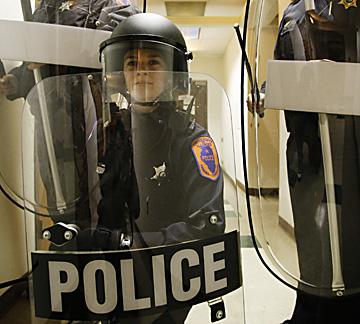Campus plans responses to emergencies

The University of Illinois police demonstrate use of riot shields at their campus facility, Monday. Erica Magda
January 29, 2008
In order to respond to emergency situations like fire evacuation plans and terrorist attacks, the Office of Campus Emergency Planning is in the process of interweaving the federal government’s National Incident Management System prescribed protocol into its emergency response protocol.
“One of the very first decisions that confronts people is, ‘How do I respond?'” said Kip Mecum, director of Emergency Planning. In addition to NIMS, Mecum cites table-top exercises, campus-community communication and terrorist-attack simulations to ensure that people will respond quickly and effectively.
“We spend eight hours a day planning, preparing, practicing for stuff we hope never happens,” said Mecum. Nevertheless, Mecum acknowledged that disasters of all kinds – tornadoes, bomb threats or terrorist plots – happen regularly enough to necessitate proactive and ongoing preparation.
“When it comes to domestic terrorism, the University presents more delectable targets just because of the nature of the research we’re involved in,” he said.
Other potential emergencies include meningitis or infectious diseases outbreaks in the campus environment.
Get The Daily Illini in your inbox!
“These sorts of events unfortunately are affecting college campuses across the country,” Mecum said.
In response to ever-present threats, Todd Short, police officer assigned to OCEP, has been busy teaching close to 1,000 people on campus how to manage an incident according to NIMS protocol.
“Everyone from Arthur Anderson to the University of Illinois police department shall use (NIMS) during the event of a crisis,” Short said. Short said the main strength of the National Incident Management System is that it is applicable to every crisis.
He said he tailors his training to the University by studying examples of incidents that occurred in the past as a learning tool.
“Federal training is very University specific because it has to be,” Short said. “We’re not going to send deans, directors and department heads through the training if it’s not going to be applicable to what they do everyday. Or what they could be doing six months from now or six minutes from now when the big one hits.”
Short’s training intends to facilitate fast and prepared responses to disasters, whether sudden or scheduled, as is the case with Unofficial St. Patrick’s Day.
“Preparation is everything,” Short said. In addition to instruction, the OCEP Web site (ocep.uiuc.edu) has added an active threat template, which is an appendix for pre-existing campus emergency plans units across campus have already developed.
Instead of rewriting their campus emergency plans, units can use the active threat template as a checklist during an emergency.
“Anybody across campus can have access to very pertinent information,” Short said. The template was addressed with the shootings at Virginia Tech in mind.
Additionally, Mecum has commenced meetings with facility managers on campus to consider the possibility of a campus lock-down procedure.
The procedure aims to literally lock down up to 250 to 300 campus buildings as quickly as possible.
“The point is to keep the bad guy out and restrict his accessibility to buildings on campus,” said Mecum. The procedure would prevent someone from gaining access to buildings as Seung-Hui Cho did on the Virginia Tech campus.
Mecum is also working with facility managers to identify tornado shelters in every building.
By the end of February, he hopes to post on the Web site the locations of each building’s tornado facility. In addition, Mecum is bolstering fire evacuation policies.
“We’ve done a great job teaching people how to use fire extinguishers but precious little time teaching people how to evacuate a facility,” he said. The evacuation plans include identifying locations where people with special needs can seek safety in areas of refuge assistance until they can be evacuated.
Proper emergency response also demands appropriate actions on the part of students.
Lt. Skip Frost, bomb squad commander, said he wants to ensure that students see the police as a resource trained, prepared and willing to help.
“In 20 years on this job, it’s always amazing to me that people are so hesitant to call the police on what are generally very significant issues,” Frost said.
Enhancements to the emergency response system stem from the value of every student life, every human life, Frost said.
“We can rebuild any thing; we can’t rebuild people,” Frost said.
Mecum stressed preparation, awareness and proactive readiness so that an emergency becomes an experience rather than an ordeal.
Short added, “My biggest fear is that if something actually occurred on this campus that I would not be here at the time it occurred to help in its response.”






